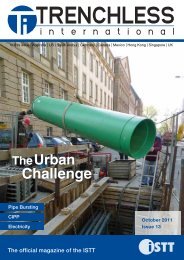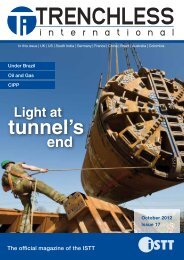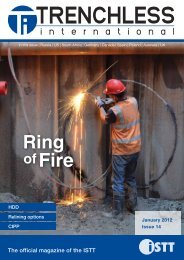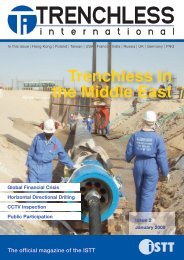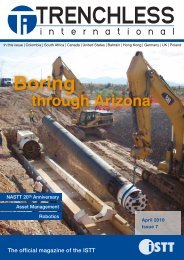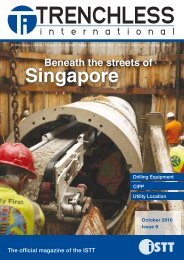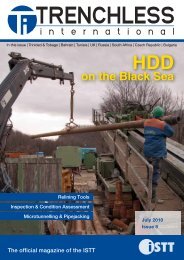North American Special - Trenchless International
North American Special - Trenchless International
North American Special - Trenchless International
Create successful ePaper yourself
Turn your PDF publications into a flip-book with our unique Google optimized e-Paper software.
obotics<br />
April 2009 - <strong>Trenchless</strong> <strong>International</strong><br />
The role of robotics in the<br />
trenchless industry<br />
by Paul Heenan<br />
The official definition of a robot is “a machine or device that operates automatically or by remote<br />
control,” yet this does not really define the information and functions that the robots in the<br />
<strong>Trenchless</strong> Technology industry provide to engineers from local water authorities, municipalities and<br />
other utility owners.<br />
It can be argued that the first step<br />
towards what we know today as ‘robots’<br />
was the use of tube cameras to inspect<br />
mainline sewers – CCTV inspection. This<br />
system of cleaning and winching the camera<br />
through the sewer was very labour<br />
intensive and, due to these manpower<br />
requirements, quite expensive. Despite<br />
this, the information gathered was invaluable<br />
in the asset management project.<br />
The problem with the winch system was<br />
that it required an entry and exit manhole;<br />
to operate this system two access points<br />
were required. For example, laterals that<br />
connect from the property directly into<br />
the main sewer lack the appropriate<br />
access. The advent of the cable and<br />
drain rods pushing system facilitated<br />
these inspections. This was further developed<br />
by Pearpoint Limited of the UK<br />
(now part of SPX) when the conductors<br />
that transferred the camera image to the<br />
control screen were incorporated inside<br />
a semi rigid rod, removing the need for<br />
a separate cable and rod. Finally the<br />
advance in technology of CCDs that<br />
produce the image surpassed the use of<br />
tube cameras and monochrome pictures<br />
were replaced by colour.<br />
The first camera-mounted robots –<br />
crawlers/tractors – provided completely<br />
new scope of possibilities. These robots<br />
enabled increased inspection distances,<br />
single entry point inspection and eventually<br />
‘pan and tilt’, which allowed the<br />
inspection of laterals from the main sewer<br />
to the building. It was a major step for<br />
the industry. Whether they were ‘shaft<br />
driven’ or ‘chain driven’, the only limitation<br />
became the loss of picture quality over<br />
greater distances.<br />
The risk of explosion created in sewers<br />
or confined spaces produced the next<br />
generation of robots. The advance in this<br />
particular industry gave rise to explosion<br />
proof systems, either by means of ‘flame<br />
paths’ or ‘inert gas-filled,’ the robots can<br />
now travel and inspect pipes that, 20<br />
years ago, were uncharted territory.<br />
All of this advancement had to be coordinated<br />
and the results assessed using<br />
a single system of examination.<br />
In 1974, the Water Research Centre in<br />
Swindon, UK provided such a method of<br />
evaluation. The system of fault classification<br />
and fault severity is used worldwide<br />
in both normal sewer (OX20) and brick<br />
sewer (OX21). The classification of grading,<br />
1 (good) to 5 (collapsed or near<br />
collapse), allows local water authority<br />
engineers, municipalities or other utility<br />
owners to set priorities in the next step<br />
of sewer robotics – sewer rehabilitation.<br />
So were CCTV inspection cameras the<br />
original robots According to the definition,<br />
cameras with remote functions such<br />
as focus, iris and rotate functions, and<br />
crawler/tractors obviously qualify. They<br />
were and still are an extension of the<br />
human eye.<br />
Robots in sewer rehabilitation<br />
If CCTV inspection is an extension of the<br />
human eye, repair robots are an extension<br />
of the human hand. These types of<br />
robots are performing tasks remotely<br />
and the benefits they provide, either<br />
financially or solution wise, are incalculable.<br />
The introduction of <strong>Trenchless</strong><br />
Technology gave local engineers a more<br />
cost effective and cost efficient method<br />
to maintain the sewer systems within their<br />
control. Especially pertinent in today’s<br />
financial situation, using trenchless solutions<br />
makes the sewer infrastructure<br />
rehabilitation budget stretch that little bit<br />
further. The old idea of ‘dig it and fill it’ is<br />
expensive and intrusive; in comparison<br />
non-disruptive, remote repair by robot is<br />
unobtrusive and inexpensive.<br />
There are two main classes of rehabilitation<br />
robot, those that grind or cut<br />
and those that repair leaking joints or<br />
laterals.<br />
Grinding or cutting robots are the<br />
teeth of the sewer rehabilitation industry,<br />
removing intruding laterals or re-opening<br />
the laterals of relined pipes can be done<br />
with ease. The fundamental question that<br />
arises is how the grinding/cutting can be<br />
achieved quickly and cost effectively.<br />
There are two main methods:<br />
1. Air driven systems: air driven motors<br />
that are used in the grinding produce<br />
a good result in some materials, but<br />
not in all. The torque produced at<br />
the point of grinding/cutting can be<br />
considerably less than the alternative,<br />
hydraulic driven. The other problem,<br />
as most people are aware, is reliability<br />
and maintenance. The amount<br />
of debris and vibrations created during<br />
the process can cause slow and<br />
expensive repairs.<br />
2. Hydraulic driven systems: the use of<br />
hydraulic methods has shown that the<br />
vibrations and debris have no effect on<br />
the reliability of the system. The torque<br />
produced at the point of grinding/cutting<br />
easily and quickly deals with any<br />
material. This makes the system more<br />
cost effective and efficient. Although<br />
the amount of investment required in<br />
owning such a system can be higher<br />
than air driven systems, the difference<br />
is soon recovered with the increase of<br />
productivity.<br />
KATE-PMO AG of Freienbach,<br />
Switzerland, a leading manufacturer of<br />
hydraulic driven grinding/cutting robots<br />
for over 20 years, pioneered the use of<br />
this type of robot system and still has<br />
originally manufactured systems working<br />
in Germany today.<br />
Lateral repairs<br />
In 2004, an independent German<br />
organisation IKT (Institut für Unteridische<br />
Infrastruktur), together with 26 sewage<br />
network operators from different cities,<br />
assessed the different methods available<br />
for the repair of sewer pipe lateral connections.<br />
In order to assess the products<br />
capability of sealing internally and externally,<br />
the repairs ranged from standard<br />
damage to strong damage. A system of<br />
measurement was introduced:<br />
• Very good – 1.0 to 1.5<br />
• Deficient – 5.6 to 6.<br />
Seven robotic systems were tested and<br />
comparatively evaluated. In these tests it<br />
was shown that the system of repair from<br />
KATE-PMO AG was the highest rated<br />
product. Using the lateral shield, more<br />
than one repair can be carried out in the<br />
sewer length at any one time. The shield<br />
can be adjusted to suit the angle of entry<br />
into the sewer making a perfect mould for<br />
the resin to bond to the pipe material.<br />
Alternative robots in the sewer<br />
The use of sewers to deploy cables<br />
is not a new idea; it was first pioneered<br />
by the French in Paris at the turn of the<br />
1900s. Robots have been developed by<br />
companies, including KATE-PMO AG, to<br />
deploy fibre optic cables in sewers with<br />
diameters from 200 mm up to and including<br />
700 mm. What is special about this<br />
system is the software that creates a<br />
map of the sewer line. Each joint, lateral<br />
or defect is measured and recorded.<br />
The position of the tubes is set by the<br />
clamps installed in the sewer length in<br />
order to avoid interfering with laterals<br />
and the primary use of transportation of<br />
waste material. More than 400,000 metres<br />
have been installed to date with minimum<br />
excavation, making it an environmentally<br />
friendly solution for telecommunication<br />
companies, disaster recovery situations<br />
and local authorities.<br />
The Future<br />
The future for robotics in sewers is<br />
vast, and the ever increasing market in<br />
<strong>Trenchless</strong> Technology will no doubt<br />
provide new advances in the design,<br />
manufacture and materials. Reliability<br />
and quality must be maintained in order<br />
to consolidate the trenchless industry in<br />
today’s market place.<br />
Paul Heenan is the <strong>International</strong><br />
Sales and Marketing Manager<br />
for KA-TE.<br />
Robotics<br />
April 2009 - <strong>Trenchless</strong> <strong>International</strong><br />
32<br />
33






